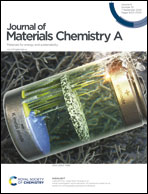Grape juice: an effective liquid additive for significant enhancement of thermoelectric performance of Cu2Se†
Abstract
The reduction of thermal conductivity and enhancement of electrical properties is the ultimate goal for achieving high-performance thermoelectric materials. In this paper, a high thermoelectric performance is demonstrated when grape juice is used as an additive to Cu2Se. High temperature processing of the mixture pyrolyzes the sugars in the grape juice and provides a fine-scale and well-mixed dispersion of elemental carbon in the Cu2Se matrix. These materials show a significant enhancement of electrical conductivity due to a high hole concentration with little change of the Seebeck coefficient, leading to an ultra-high power factor of 1.3 mW m−1 K−2 at 984 K. Microstructural studies reveal that the carbon phase is embedded on the Cu2Se grain boundaries and that Cu2O nanoparticles are located at the interface between carbon and Cu2Se. This results in phonon scattering at the interface which leads to a reduction of thermal conductivity of up to ∼38%. It is proposed that the formation of Cu2O also induces Cu deficiencies in Cu2Se resulting in greater enhancement of electrical conductivity. As a result, the zT is significantly enhanced up to ∼2.5 at 984 K. This study opens up a new avenue for enhancing the properties of thermoelectric materials.



 Please wait while we load your content...
Please wait while we load your content...